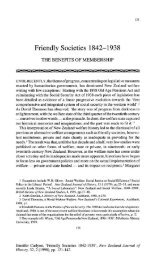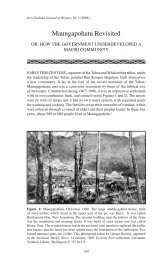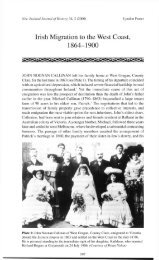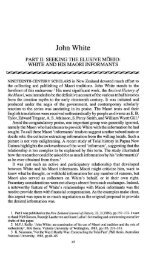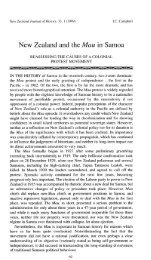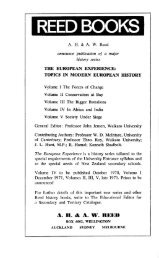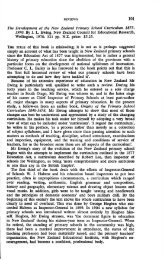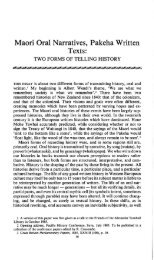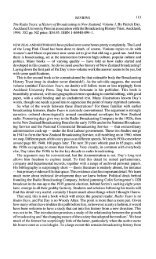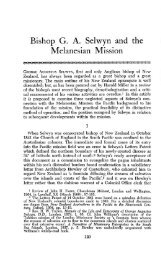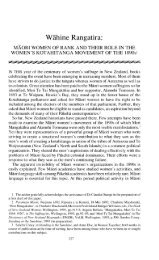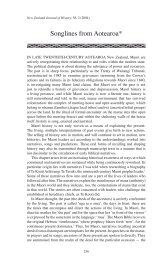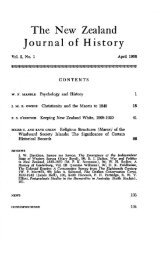Maori Oral Narratives, Pakeha Written Texts: - New Zealand Journal ...
Maori Oral Narratives, Pakeha Written Texts: - New Zealand Journal ...
Maori Oral Narratives, Pakeha Written Texts: - New Zealand Journal ...
Create successful ePaper yourself
Turn your PDF publications into a flip-book with our unique Google optimized e-Paper software.
MAORI ORAL NARRATIVES, PAKEHA WRITTEN TEXTS 21<br />
rative. But the ancestors about whom the history is told are always their<br />
own.<br />
Genealogy is the backbone of all <strong>Maori</strong> history. Critical narratives may<br />
therefore be rearranged, in both time and place, around the appropriate<br />
ancestors. <strong>Maori</strong> oral narrative history is obviously concerned with its own<br />
leaders. They may not necessarily be those who have been particularly<br />
noticed in the European world. There will also be conflicts between narratives,<br />
as whakapapa and kin order their priorities and their truths. <strong>Maori</strong><br />
history is agonistic, and old conflicts will be refought in words, as anyone<br />
who listens to whaikorero on the marae will know. It is, therefore, extremely<br />
difficult simply to insert an oral tradition into a written text which purports<br />
to deal with the same events.<br />
For example, one of the favourite devices in all oral narrative traditions<br />
is the riddle. The riddle is a form of structuring, like the parable, that<br />
enables new meanings to be found in old stories. A riddle is a test for the<br />
listeners as well as for those in the story. In the story the task is usually set<br />
by those with access to knowledge which is ultra-human in its source. The<br />
answer will only be discovered by those with faith. Here is a riddle told concerning<br />
the successful escape of the whakarau from the Chatham Islands in<br />
1868. In this story, the Archangel Michael sets a task for the prisoners:<br />
And before, Te Kooti referred to this Angel, Michael, coming to rescue them. He<br />
said to them, 'Look, here's a stone! I want you people to eat it. If your faith is good,<br />
you can do it.' So I believe old Penehau put it in his throat — almost choke —<br />
couldn't get it down — too big! So, they had a session with one another. 'How we'<br />
going to eat that stone?' Just saw old Pene trying to perform, how to swallow it — it<br />
won't work! So, all right: 'Let's all put it to God. Tell God to help us.' And when<br />
they went to sleep it was given to one of them in a dream. He woke up startled, and<br />
he said, 'I've got it! I've got it! I've got it!' And they all woke up and said, 'What?'<br />
'Oh, how to eat that stone.' And he got that stone and pounded it into dust. Got it all<br />
into dust and he gave you a bit. That's how we were told.<br />
Heni: That's the sharing. That's right. 'Cos my great-grandmother ate that stone.<br />
Ned: 'Cause Te Kooti said, 'You people got to swallow that stone.' But they<br />
couldn't find an answer. But in a dream, after their prayers, the Lord blessed them.<br />
This particular person was given the understanding. Everyone of them had a bit. So<br />
they were rescued [from Wharekauri]. 11<br />
In this manner, the understanding of the mystery, the solving of the riddle,<br />
gave the prisoners their deliverance.<br />
The systems of explanation which are embedded in the narrative traditions<br />
create the mental world which the people inhabit. Their decisions and<br />
actions — their 'history' — are all influenced by their systems of belief. Rua<br />
Kenana's first wife, Pinepine Te Rika, became a tapu woman. She became<br />
tapu from about 1905, the time when she, according to the oral narrative<br />
traditions of the Iharaira, the followers of Rua, climbed the sacred moun-<br />
11 Conversation with Ned and Heni Brown, 14 February 1982.



